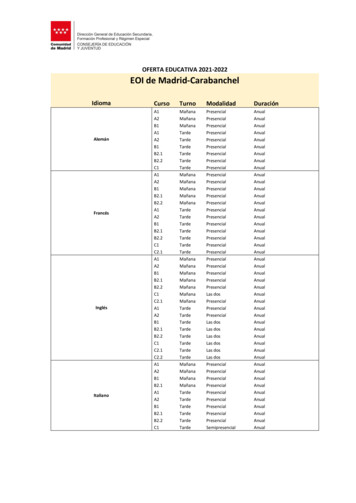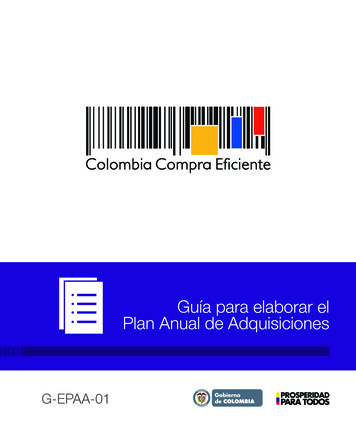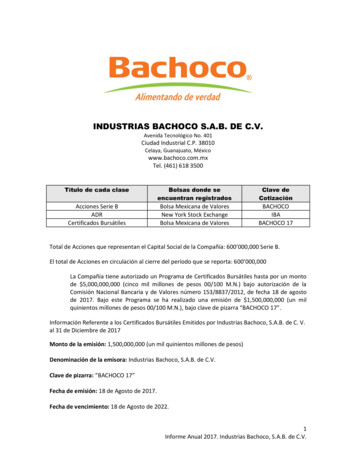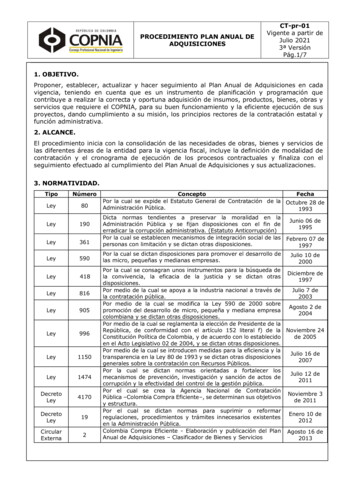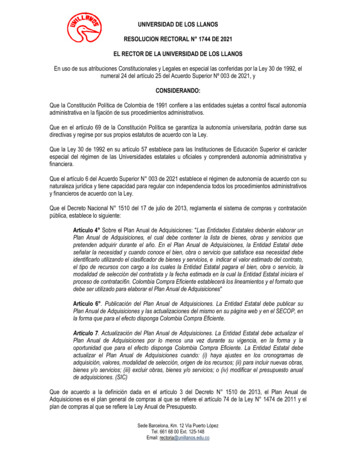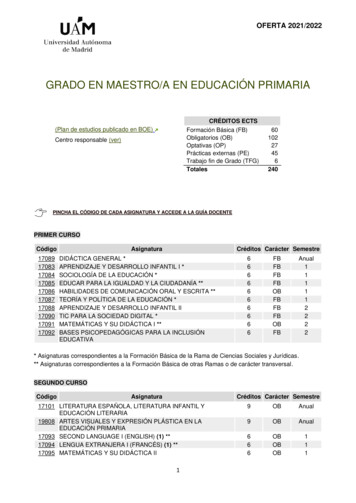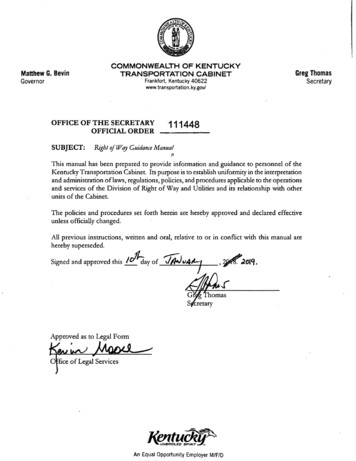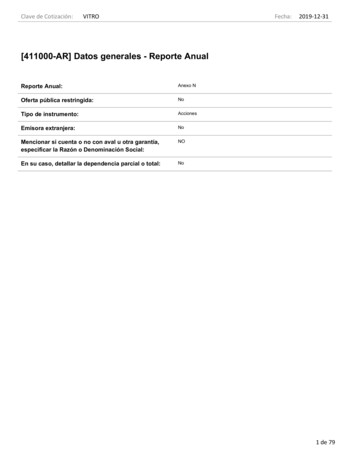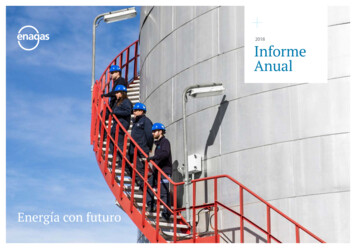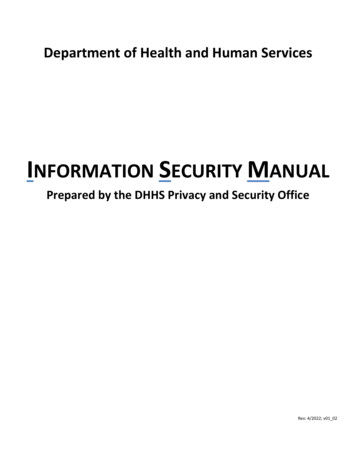
Transcription
Department of Health and Human ServicesINFORMATION SECURITY MANUALPrepared by the DHHS Privacy and Security OfficeRev: 4/2022; v01 02
North Carolina Department of Health and Human Services Privacy and Security OfficeAll material presented in this publication is provided under a Creative Commons Attribution-NonCommercial-ShareAlike 3.0 United States -sa/3.0/us/)Inquiries regarding the license and any use of this document are welcome at:DHHS.Security@dhhs.nc.govv01 021
Table of ContentsCHAPTER 1: INTRODUCTION TO THE INFORMATION SECURITY PROGRAM .51.1 Purpose .51.2 Approach.51.2.1 Alignment with the Statewide Information Security Manual .51.2.2 Alignment with the Framework for Improving Critical Infrastructure Cybersecurity .51.2.3 Alignment with Information Security Best Practices .51.3 Applicability .6CHAPTER 2: PERSONNEL SECURITY.72.1 Pre-Employment Screening .72.2 Documentation of Job Descriptions .72.2.1 Separation of Duties and Least Privilege Requirements .72.3 Workforce Authorization and Clearance .72.3.1 Third-Party Contractors .72.4 Workforce Disciplinary Actions .82.5 Separation of Service Requirements .82.5.1 Termination of Employment .82.5.2 Transfer of Employment .82.5.3 Temporary Separation of Service .82.6 Handling Personnel Information.92.7 Information Security Education Training and Awareness (SETA) .92.7.1 Developing a Security Education Training and Awareness Program .92.7.2 Delivering SETA to Workforce Members .112.7.3 Program Evaluation and Feedback .122.7.4 Professional Development and Education .122.7.5 Training Documentation .122.8 Personnel Safety .12CHAPTER 3: DATA LIFECYCLE MANAGEMENT .133.1 Data Ownership .133.1.1 Criteria of Ownership .133.2 Data Classification, Naming and Labeling .133.2.1 Data Classification .133.2.2 Data Naming .143.2.3 Data Analysis Protection .143.2.4 Data Labeling.153.3 Roles and Responsibilities Related to Data Management .153.3.1 Recording Roles and Responsibilities .153.4 Data Flow Diagram Development .163.5 Data Access .163.6 Records Management .163.6.1 HIPAA Retention Requirements .163.7 Isolating Health Care Clearinghouse Functions .17v01 022
CHAPTER 4: SYSTEM ACQUISITION, DEVELOPMENT AND MAINTENANCE .184.1 System Development Life Cycle (SDLC) .184.2 Secure Coding Standards .194.2.1 Securing System Development Code .194.3 Security for Systems Contracts .19CHAPTER 5: LIFE CYCLE SECURITY MANAGEMENT .215.1 SDLC: Initiation / PLC: Initiation .215.1.1 Initiate Security Planning .225.1.2 Categorize the Information System .235.1.3 Assess Business Impact .245.1.4 Data Classification Assessment .255.2 SDLC: Development/Acquisition / PLC: Planning and Design .265.2.1 Assess System Risk .265.2.2 Select and Document Security Controls .275.2.3 Design Security Architecture .285.2.4 Engineer in Security and Develop Controls .295.2.5 Develop Security Documentation .315.2.6 Conduct Testing (Developmental, Functional and Security) .325.3 SDLC: Implementation/Assessment / PLC: Execution and Build .335.3.1 Integrate Security into Established Environments or Systems .335.3.2 Assess System Security .355.3.3 Authorize the Information System.365.4 SDLC: Operations and Maintenance / PLC: Implementation .365.4.1 Review Operational Readiness .375.4.2 Configuration Management and Control .385.4.3 Continuous Monitoring.395.5 SDLC: Disposal / PLC: Closeout .405.5.1 Build and Execute a Disposal/Transition Plan .415.5.2 Ensure Data Preservation .415.5.3 Sanitize Media .435.5.4 Dispose of Hardware and Software .445.5.5 Closure of System .455.6 Legacy System Considerations .45CHAPTER 6: RISK MANAGEMENT .466.1 Framing Risk .466.2 Assessing Risk .476.2.1 System Security Risk Assessment .486.3 Respond to Identified Risk .486.3.1 Plan of Action and Milestones.496.3.2 Risk Assessment Supplemental Information .496.3.3 Risk Response Time Frames .506.4 Monitor Risk .506.4.1 Continuous Risk Monitoring Strategy .506.5 Vulnerability Management .516.6 Security-Focused Configuration Management (SecCM) .52v01 023
6.7 Risk Acceptance .52CHAPTER 7: DATA SECURITY ENHANCEMENTS .537.1 Security Plan Development .537.2 Media Security .547.2.1 Remote Access.547.3 Cloud Security .557.4 Social Media Security .557.5 Security Assessments and Monitoring.567.6 Personally Owned Equipment and Software .567.7 Physical Security .587.8 Access Controls .597.8.1 Identification and Authentication .597.9 Capital Planning and Budgeting .59CHAPTER 8: CONTINUITY OF OPERATIONS PLANNING (COOP) .608.1 Business Continuity Planning (BCP) .618.1.1 Identification of Application Criticality .618.2 Business Impact Analysis (BIA) .628.3 Risk Management within Continuity of Operations .628.3.1 Adherence to Security Controls .628.4 Continuity Plan Testing and Training .638.4.1 Testing .638.4.2 Training.63CHAPTER 9: SYSTEM AUTHORIZATION.649.1 Authorization Package .649.2 Authorization Decisions .659.2.1 Authorization Rescission .659.3 Authorization Decision Document .66CHAPTER 10: INCIDENT RESPONSE .6710.1 Incident Reporting .6710.1.1 Reporting Incidents Involving Social Security Administration (SSA) Data .6810.1.2 Reporting Incidents Involving Federal Tax Information (FTI) .6810.1.3 Reporting Incidents Involving Centers for Medicare & Medicaid Services (CMS) .6810.1.4 Incident Categorization and Severity.68CHAPTER 11: NC DHHS Security Manual Updates .72v01 024
CHAPTER 1: INTRODUCTION TO THE INFORMATION SECURITY PROGRAM1.1 PurposeDivisions and Offices (see below) are becoming more dependent on information technology (i.e., systems) and the data containedwithin to successfully carry out their essential functions and business services. Systems (see below) can include as constituents abroad range of technologies (e.g. individual components; network and telecommunication systems; computers; tablet; smartphones; etc.) and services. DHHS faces an ever-changing threat-landscape that can have adverse impacts on Department operations(e.g. essential functions, business services, regulatory compliance, reputation, and financial), Department assets, individuals,partner Divisions and Offices, and the State by compromising the confidentiality, integrity, or availability of data entrusted to DHHSand being processed, stored, or transmitted by Department systems. Threats to data and systems include environmentaldisruptions, human or machine errors, and purposeful attacks (e.g. cyber-attacks which are often aggressive, disciplined, wellorganized, well-funded, and in a growing number of documented cases, very sophisticated). Given the significant and growingdanger of these threats, it is imperative that all levels of the organization understand their responsibilities for achieving adequatedata security and for managing system-related security risks.The term organization is used in this manual to describe an entity of any size, complexity, or positioning within the DHHSDepartment structure (e.g. divisions, offices or as appropriate, any of the department’s operational elements).A system is a discrete set of information resources organized for the collection, processing, maintenance, use, sharing,dissemination, or disposition of data used or operated by an organization, a contractor of an organization, or by a third-party onbehalf of a DHHS organization.1.2 ApproachThis manual is designed to be a baseline for the application of a risk-based approach (see Chapter 6: Risk Management) to protectingDepartment data and systems and based on the principle that the right to data protection is a qualified right. Because of this it isnot designed to function as a standalone document or intended to be the de facto security rule; but rather it is to be used inconjunction with the Statewide Information Security Manual and enhanced through the creation of organization-specific standards,policies, and processes as required.This manual does not override any Department obligations imposed by legislation or law. Furthermore, if this manual conflicts withlegislation or law the later takes precedence.1.2.1 Alignment with the Statewide Information Security ManualThe Statewide Information Security Manual wis based off of the NIST 800-53 R4 framework and serves as the foundation forinformation technology security in North Carolina. Specific requirements, practices and recommendations contained within theStatewide Information Security Manual are not repeated within this manual unless required for clarity of material.1.2.2 Alignment with the Framework for Improving Critical Infrastructure CybersecurityIn February 2013, the Office of the President issued the Executive Order on “Improving Critical Infrastructure Cybersecurity “. TheFramework gathers existing global standards and practices to help Divisions and Offices understand, communicate, and managetheir cyber risks. The risk based approach of the DHHS Information Security Manual coupled with the State foundational frameworkis designed to align with our responsibilities in regards to Critical Infrastructure Cybersecurity.1.2.3 Alignment with Information Security Best PracticesBuilding upon the foundation laid by the Statewide Information Security Manual, DHHS has chosen to adopt best practice standardsas detailed by the National Institute of Standards and Technology (NIST) to provide security enhancements and guidance toDepartment data and systems.1.2.4 Maintenance, Reviews and UpdatesNC DHHS Security Manual reviews and updates shall be conducted on an annual basis. New policies shall be reviewed by the DHHSv01 025
Privacy and Security Office and routed to authorized personnel for approvals. Material revisions shall be reviewed and approved atthe discretion of authorized personnel. Policies shall be approved prior to publishing to make accessible for all Divisions and Offices.All approved policies shall be provided to Divisions and Offices to include documentation of review dates, update dates, andapproval dates for maintenance. NC Divisions and Offices shall maintain their program specific policies and procedures and ensurethey align with DHHS Security Manual where applicable to include annual review, updates, and documentation of approval andenforcement.Updates to the Statewide Information Security Manual shall be reviewed annually and as made available by the North CarolinaDivision of Information Technology. Updates to the Statewide Information Security Manual shall be reviewed annually and adoptedwithin 90 days where there are more restrictive implementation requirements that impact NC DHHS Offices and Divisions. Versioncontrol numbers will be assigned based on type of revision as minor or major. Minor revisions will show version control number(vX XX), major revisions will show v(XX). “v” shall mean version and “XX” indicates the number.1.3 ApplicabilityUnless denoted by applicability all sections and subsections of this manual are required by all Divisions and Offices. Additionally, alldevices, equipment and systems accessing Department data must meet statewide, departmental and applicable federal securitycontrols or have appropriate mitigations. Control mitigations requirement compliance must be documented.Divisions and Offices shall develop a policy and procedure where there are program specific federal requirements as applicable andare not less restrictive than this policy manual, Statewide Information Security Manual, and other state or federal requirements.Contracts with vendors shall reflect the grace period of 90 days to implement applicable change and addendums into the contractlanguage.-- Remainder of Page Intentionally Left Blank --v01 026
CHAPTER 2: PERSONNEL SECURITY2.1 Pre-Employment ScreeningDivisions and Offices must follow DHHS Division of Human Resources and the Office of State Human Resources policies and proceduresfor the conducting of pre-employment screenings. Pre-employment screening includes but is not limited to; reference checks, criminalhistory checks, educational verification, license verification, and sanctions checks.2.2 Documentation of Job DescriptionsIn accordance with the DHHS Division of Human Resources and the Office of State Human Resources, Divisions and Offices shall create,document, and monitor their workforces’ job descriptions. Job descriptions must clearly and accurately define all roles andresponsibilities for all job functions including but not limited to duties, responsibilities, required qualifications, reporting structure (i.e.manager’s title, dotted line reporting relationships, etc.) and types of data to be accessed (i.e. Health Insurance Portability andAccountability Act (HIPAA), Internal Revenue Service (IRS), Social Security Administration (SSA), etc.)Workforce job descriptions shall be used during the process of determining training requirements, business need identification, andfor ensuring workforce members are assigned appropriate levels of access rights. Workforce member must be provided with a copyof their job description when they are informed of the access granted to them, and the conditions by which this access can be used.GuidelinesIn an effort to avoid missing key functions, job descriptions must be developed in cooperation with Department Human Resources(HR) officers but written by individuals with first-hand knowledge of job requirements and inner workings. Accurate and well thoughtout job descriptions can not only be used as part of a performance management process but serve as a foundation for the separationof duties.2.2.1 Separation of Duties and Least Privilege RequirementsDivisions and Offices shall ensure that workforce members’ roles and responsibilities are based on separation of duties and leastprivileges to ensure that security access levels are appropriately distributed.Workforce members are required to segregate access between users who have access to confidential information and those who donot. Divisions and Offices must also ensure that appropriate controls for access extend between themselves and their outsourcedfunctions.GuidelinesDocumented reporting structures identifying to whom and for what purpose individuals report should be used to assist in evaluationfor appropriate accountability, and aid in implementing separation of duties and least privilege. As part of the reporting structurereview individual’s Independence of Operation (i.e. the authority for individuals to make decisions and the way in which they arereferred upwards for action/approval), and the extent of supervision required (e.g. work is fully-checked, spot-checked or generallyreview, etc.) should be looked at including the potential impact of decisions, actions and recommendations.2.3 Workforce Authorization and ClearanceAll Department workforce members must comply with required federal, state and department regulations. When employing orcontracting new workforce members, Divisions and Offices must ensure that each new workforce member completes any requiredsecurity, privacy or regulatory training prior to allowing access to confidential data.2.3.1 Third-Party ContractorsIn order to perform the requested services, a third-party contractor may need to utilize departmental information resources and/oraccess confidential information. In these instances, Divisions and Offices must ensure that access granted is the minimum necessaryrequired for performing roles and responsibilities. The appropriate Data Steward must approve and have full knowledge of the accessrights obtained by the third-party contractors.v01 027
Data and information belonging to the department must not be released to third-party contractors without proper documentedagreements, specifying the conditions of use and security requirements in place, between the third-parties and organizationmanagement. These documents may include but are not limited to non-disclosure agreements (NDA), business associate agreements(BAA) and service level agreements (SLA).Third-party contractors should be fully contractually accountable to the organization for any actions taken while completing their rolesand responsibilities. Divisions and Offices must ensure that applicable federal, state and departmental regulations are communicatedto third-party contractors.GuidelinesDivisions and Offices shall develop and implement procedures for the determination and authorization of all (e.g. third-parties,business associates, vetted employees, contractors, etc.) who have access to federal, state, departmental networks, information ordata.2.4 Workforce Disciplinary ActionsDivisions and Offices shall develop policies and procedures for appropriately applying sanctions (e.g. reprimand, termination) againstworkforce members that fail to comply with required security regulations.All sanctions must conform to the policies, procedures, standards, and guidelines handed down by the DHHS Division of HumanResources, and the Office of State Human Resources. In addition, all DHHS workforce members with potential access to ElectronicProtected Health Information (ePHI) must have a signed copy of the “Understanding of DHHS HIPAA Sanctions”.2.5 Separation of Service RequirementsA separation of service occurs but is not limited to when the DHHS workforce member resigns, retires, is dismissed/terminated,selected for reduction in force (RIF) or transfers to a state agency external to DHHS. Divisions and Offices shall develop policies andprocedures for appropriately handling workforce separation of service.2.5.1 Termination of EmploymentDivisions and Offices must implement procedures to ensure that when a workforce member's employment terminates: All system accounts are terminatedAll access to departmental information/data is removedAll access to facilities, including but not limited to card access, keys, codes, and other facility access control mechanisms isterminated Workforce Identification (ID) Badge is collectedWork related keys including, but not limited to, office door keys, desk keys, file drawer or cabinet keys, etc., are turned inCodes or passwords for systems, equipment access passwords (firewalls, routers, etc.), administrator passwords, and othercommon access control information should be changed when appropriate The Division of Human Resources is promptly notified2.5.2 Transfer of EmploymentIf a workforce member transfers to another organization within DHHS the workforce member’s access must be terminated as of thedate of transfer. The workforce member’s new organization is responsible for establishing all required access for the workforcemember’s new role and responsibilities.2.5.3 Temporary Separation of ServiceIn some instances, as deemed necessary by
The Statewide Information Security Manual wis based off of the NIST 800-53 R4 framework and serves as the foundation for information technology security in North Carolina. Specific requirements, practices and recommendations contained within the Statewide Information Security Manual are not repeated within this manual unless required for .
